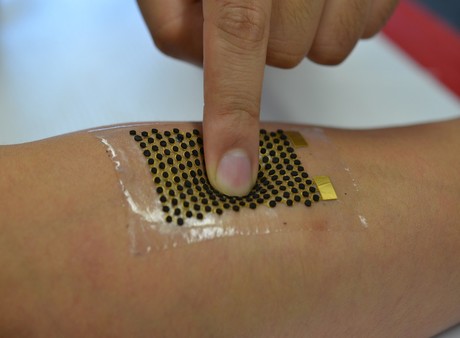Stretchable fuel cells for sweat-powered wearables

Engineers from the University of California San Diego have developed stretchable fuel cells that extract energy from sweat, which they can use to power electronics such as LEDs and Bluetooth Low Energy (BLE) radios. The biofuel cells generate 10 times more power per surface area than any existing wearable biofuel cells, according to the researchers, and could be used to power a range of wearable devices.
For some time, scientists have been struggling to make fuel cells that are both stretchable enough and powerful enough for the wearable devices they are supposed to power. The UC San Diego researchers achieved this by building a stretchable electronic foundation using lithography, plus screen printing to make 3D carbon nanotube-based cathode and anode arrays. Their biofuel cells were equipped with an enzyme that oxidises the lactic acid present in human sweat to generate current, thus turning the sweat into a source of power.
In order to make the cells flexible and stretchable, the researchers decided to use what they call a ‘bridge and island’ structure, the basis for which was manufactured via lithography and made of gold. Essentially, the cell is made up of rows of dots that are each connected by spring-shaped structures. Half of the dots make up the cell’s anode; the other half, the cathode. The spring-like structures can stretch and bend, making the cell flexible without deforming the anode and cathode.

Next, the researchers needed a way to increase the biofuel cell’s energy density — the amount of energy it can generate per surface area — which was key to increasing performance for the biofuel cells. As noted by Amay Bandodkar, a first author on the study and PhD student at the time of the research, “We needed to figure out the best combination of materials to use and in what ratio to use them.”
To increase power density, the engineers screen printed a 3D carbon nanotube structure on top of the anodes and cathodes. The structure allowed the engineers to load each anodic dot with more of the enzyme that reacts to lactic acid and silver oxide at the cathode dots. In addition, the tubes allow easier electron transfer, which improves biofuel cell performance.
The finished biofuel cell was connected to a custom-made circuit board — a DC/DC converter that evens out the power generated by the fuel cells, which fluctuates with the amount of sweat produced by a user and turns it into constant power with a constant voltage. Four test subjects were equipped with the biofuel cell-board combination, before being asked to exercise on a stationary bike. The subjects were able to power a blue LED for about four minutes.

Publishing their results in the journal Energy & Environmental Science, the engineers conceded that further work is needed in two areas. First, the silver oxide used at the cathode is light-sensitive and degrades over time, so the researchers will need to find a more stable material in the long run. Also, the concentration of lactic acid in a person’s sweat gets diluted over time, which is the reason why the subjects were able to light up the LED for only four minutes. The researchers are currently exploring a way to store the energy produced while the concentration of lactate is high enough and then release it gradually.
Soft robot uses magnetic fields to power itself autonomously
Inspired by the movement of manta rays, researchers have developed a small, magnetically powered...
Perovskite 'energy sandwich' could power next-gen solar
Researchers have achieved a new level of control over the atomic structure of halide perovskites,...
Creating the truck of tomorrow
Exploring the technological innovations, infrastructure solutions and emerging delivery methods...




